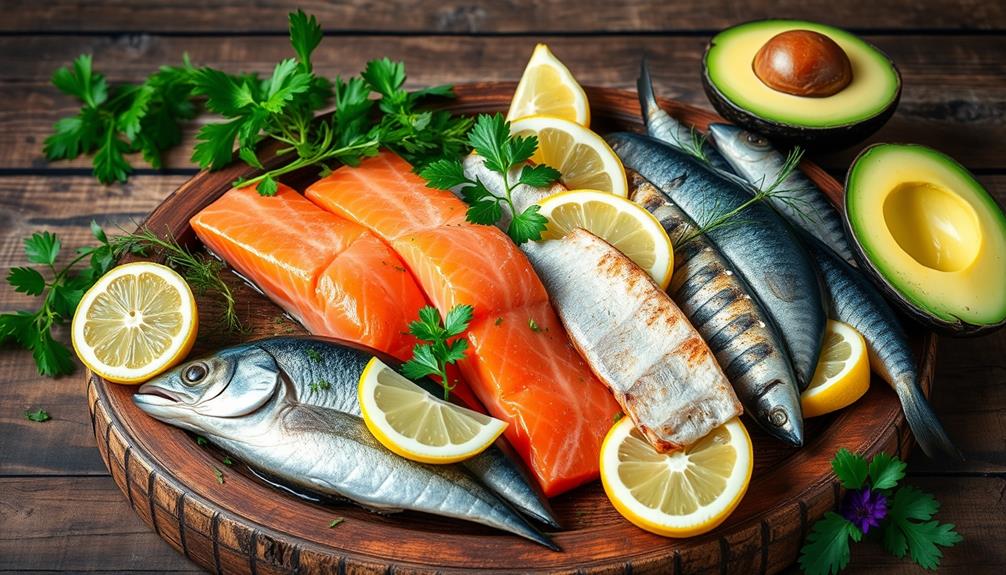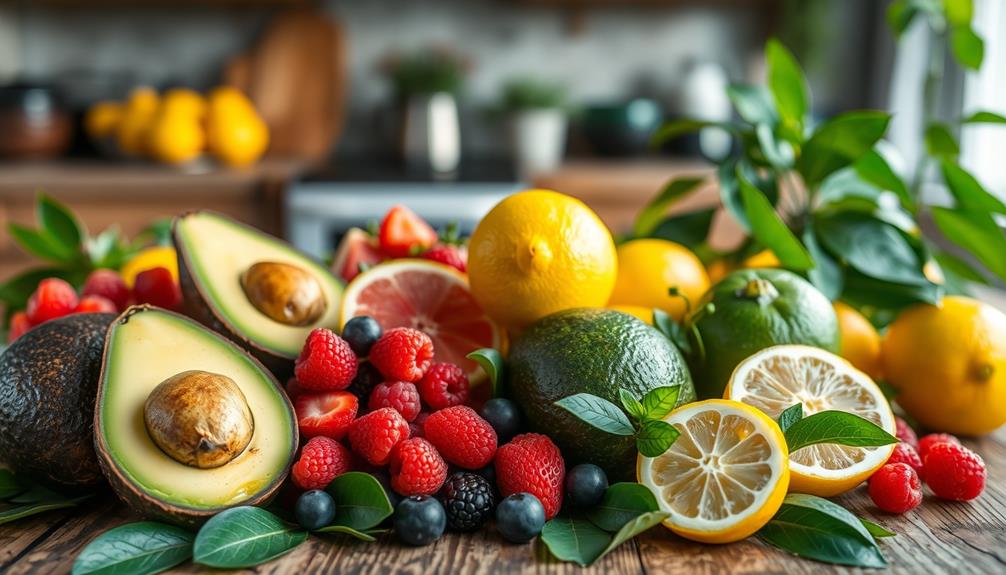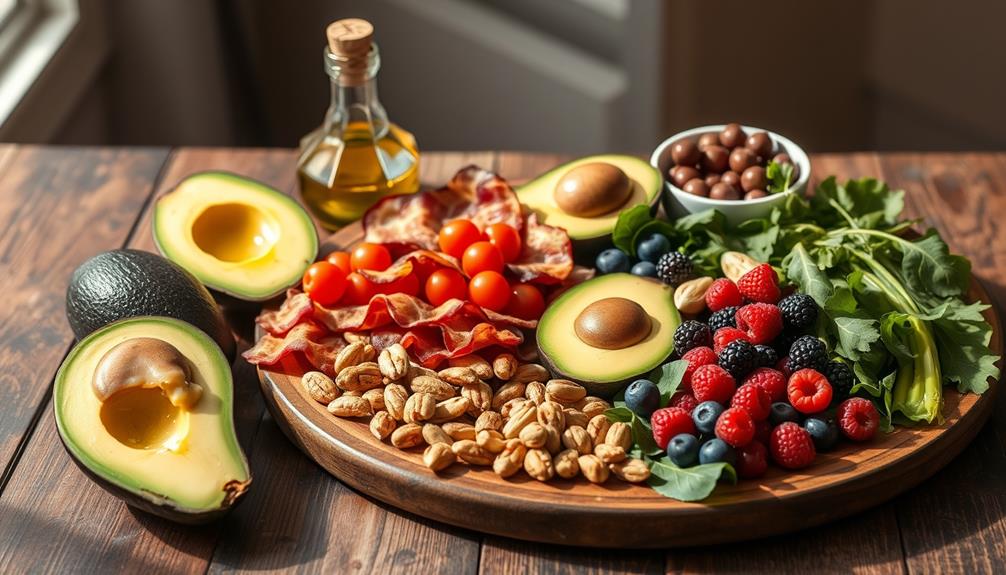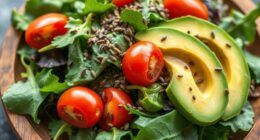Yes, green beans are definitely keto diet-friendly. They contain about 4.3 grams of net carbs per cup, making them perfect for keeping within your daily carb limits. Plus, they're rich in fiber and packed with essential vitamins like C and K, enhancing your overall nutrition. You can easily enjoy them in various dishes, whether steamed, sautéed, or added to salads. Just make sure to watch your portion sizes. Incorporating green beans into your meal plan can boost your health while keeping carbs low, and you might find some tasty cooking tips to make them even more enjoyable!
Key Takeaways
- Green beans have about 4.3 grams of net carbs per cup, making them suitable for a keto diet.
- They are low in calories (approximately 31 per cup) while being nutrient-dense and fiber-rich.
- High in vitamins C and K, green beans support immune function and bone health.
- Versatile in cooking, they can be sautéed or steamed to enhance flavor without adding significant carbs.
- Their fiber content aids digestion, benefiting those following a low-carb lifestyle.
Green Beans and Keto Compatibility

Green Beans and Keto Compatibility
When considering the keto diet, you'll find that green beans are a compatible choice. With only about 7 grams of carbohydrates per cup and net carbs totaling around 4.3 grams after accounting for fiber, green beans fit well within the low-carb guidelines of the keto lifestyle. This makes them an excellent option for keeping your daily carb intake under 50 grams while maintaining ketosis.
Additionally, green beans are often praised for their high fiber content, which may aid in digestive health and gut function beneficial for overall health.
Compared to most beans, which can range from 12 to 25 grams of net carbs per 100 grams, green beans stand out as a notably lower-carb alternative. Plus, one cup of green beans offers essential vitamins C and K, contributing to your overall nutrient intake without derailing your diet.
Their low calorie count and high fiber content promote satiety, helping you feel full without exceeding your carb limits. You can easily incorporate green beans as a side dish in your meals, adding both flavor and nutrition without worrying about breaking your keto plan.
Types of Green Beans

Green beans, also known as snap beans or string beans, come in a variety of types, each offering unique characteristics and flavors. You'll find green, purple, and yellow varieties, with the yellow ones commonly referred to as wax beans. Understanding the different types can enhance your culinary experience and support your healthy diet.
Green beans can be categorized mainly into two types: bush beans and pole beans. Bush beans produce all their yield in just 1-3 weeks, making them perfect for quick harvests. On the other hand, pole beans provide a continuous supply throughout the growing season, ensuring you have fresh green beans for longer.
Here's a quick comparison of the types:
| Type of Green Bean | Characteristics |
|---|---|
| Bush Beans | Quick harvest, all produce in weeks |
| Pole Beans | Continuous harvest throughout the season |
All varieties of green beans are low in carbs, with approximately 31 calories per cup. They're also high in fiber, offering about 2.7 grams per cup, which helps with digestive health. Plus, they're rich in vitamin K, supporting blood clotting and bone health, making them an excellent addition to your keto-friendly meals!
Carbohydrate Content in Green Beans

If you're watching your carbohydrate intake on a keto diet, green beans are a fantastic choice. One cup of these low-carb vegetables contains about 7 grams of total carbohydrates, but with 2.7 grams of fiber, the net carb count drops to approximately 4.3 grams. This makes them an ideal option for those adhering to strict daily carb limits, typically set under 50 grams on a keto plan.
Additionally, it's crucial to take into account how cold medications may impact your overall health and dietary choices, especially when managing weight or conditions like gout.
Compared to many other beans that can have anywhere from 12 to 25 grams of net carbs per 100 grams, keto green beans stand out as a notably lower carb alternative. This means you can enjoy a generous serving while still staying within your carb restrictions.
Regular portion sizes, like half a cup, easily fit into your daily carb limits while offering essential nutrients along the way.
Incorporating green beans into your meals allows you to enjoy the taste and texture you love without compromising your diet. Plus, their carbohydrate content works well with the overall goals of a keto lifestyle, making them a staple in your low-carb vegetable repertoire.
Nutritional Benefits of Green Beans

After exploring the carbohydrate content of green beans, it's clear they offer much more than just low net carbs. With approximately 4.3 grams of net carbs per cup, these veggies fit perfectly into your ketogenic diet. They also provide a unique flavor that can enhance various dishes, similar to how different brewing methods create diverse coffee experiences.
But their benefits don't stop there. Green beans are rich in dietary fiber, providing about 2.7 grams per cup, which aids digestion and promotes gut health.
Moreover, green beans are an excellent source of vitamins and minerals. They're particularly high in vitamin K, vital for blood clotting and bone health. You'll also find significant amounts of folate (Vitamin B9) in green beans, which is essential for red blood cell production and DNA synthesis.
Another standout feature is their antioxidant content. Green beans are packed with carotenoids, which support eye health and help reduce the risk of chronic diseases.
This combination of fiber, vitamins, and antioxidants makes green beans not just a low-carb option but a nutrient-dense addition to your meals. So, when you think about your keto-friendly choices, green beans should definitely be on your plate!
Preparation and Cooking Methods

When it comes to preparing green beans, you'll want to focus on techniques that enhance both flavor and texture.
Quick-steaming or sautéing with garlic and olive oil can elevate your dish while keeping it keto-friendly.
Additionally, incorporating healthy fats, such as olive oil, can help maintain overall wellness, similar to how essential oils can promote health.
Let's explore how these methods can bring out the best in your green beans.
Cooking Techniques Overview
Cooking green beans for a keto diet involves techniques that maximize both flavor and nutritional value. One effective method is quick-steaming, which preserves the high vitamins and nutrients while keeping the beans crisp. To achieve this, use minimal heat and liquid, and check for doneness after about seven minutes to confirm they're tender-crisp.
Incorporating a variety of cooking methods, such as those found in primitive weapons for modern survival, can enhance your overall preparation skills in the kitchen.
Sautéing is another fantastic option, especially when you use healthy fats like olive oil or butter. This not only adds flavor but also aligns perfectly with your keto goals. Incorporating garlic can further enhance the taste without adding net carbs per serving.
If you're looking to retain the vibrant color and crunch, consider blanching your green beans followed by an ice bath. This cooking technique helps maintain their appealing look and texture, making them a perfect keto side.
Additionally, remember to watch your portion size; even low-carb dressings and seasonings can elevate the taste without introducing sugars or excess carbs. By using these cooking techniques, you can enjoy delicious green beans that fit seamlessly into your keto lifestyle.
Flavor Enhancement Strategies
Flavor enhancement is essential for making green beans irresistible on a keto diet. To maximize their flavor while keeping them low in carbs, consider quick-steaming your green beans for just 3-5 minutes. This method preserves their nutrients and enhances their natural taste without adding calories.
For a richer flavor, sauté your green beans in healthy oils like avocado or olive oil, and toss in minced garlic to elevate their aroma. For those looking for efficient cleaning options to keep your kitchen tidy while cooking, check out the best vacuums for dust removal to maintain a clean environment.
Don't forget to sprinkle in some spices! Black pepper, red pepper flakes, or garlic powder can intensify the green beans' flavor profile without compromising your keto plan.
For an additional savory touch, add a sprinkle of freshly grated Parmesan cheese. It not only adds umami but also keeps your dish keto-friendly.
Keto Diet Overview

The keto diet is a popular approach that drastically cuts carbohydrates to about 20-50 grams per day, pushing your body into a state called ketosis.
This metabolic shift encourages your body to burn fat for fuel instead of relying on carbs, promoting fat loss and potentially boosting your energy levels.
To enhance your financial health while on a diet, it's important to create a budget that accounts for your grocery expenses, ensuring you invest wisely in common financial terms and jargon related to healthy eating.
To succeed on the keto diet, you'll need to focus on a few key elements:
- Low-Carb Vegetables: Incorporate plenty of leafy greens and cruciferous veggies to provide essential vitamins without exceeding your carb limits.
- Healthy Fats: Prioritize sources like avocados, nuts, and olive oil to fuel your body efficiently.
- Careful Planning: Be mindful of your food choices, steering clear of high-carb foods like grains and sugary items.
Recommended Low-Carb Foods
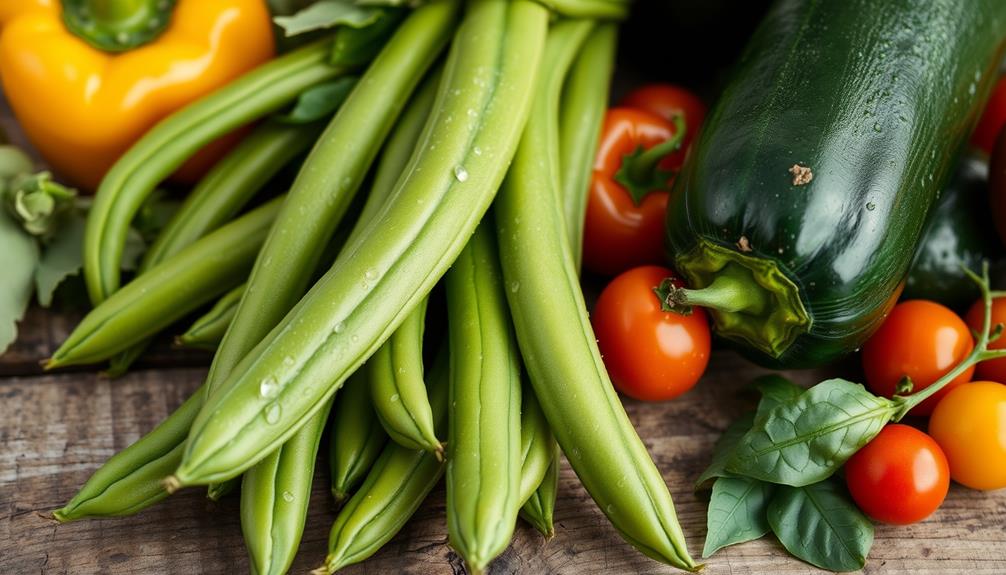
When you're following a keto diet, choosing the right low-carb foods is essential for maintaining ketosis and achieving your health goals. One of the best categories to focus on is green vegetables to eat. Leafy greens like spinach and kale are top choices, with less than 1 gram of net carbs per cup, making them perfect for your meals. Additionally, these vegetables can provide essential nutrients and antioxidants that support overall health, making them a great addition to your diet.
For more on delicious coffee varieties that can complement your meals, check out unique flavor profiles.
You should also consider cruciferous vegetables such as broccoli and cauliflower, which contain about 3-4 grams of net carbs per cup. These can easily substitute high-carb ingredients like rice and potatoes.
Zucchini is another fantastic option, offering around 2.7 grams of net carbs per cup; it can be spiralized into "zoodles" for a low-carb pasta alternative.
Don't overlook mushrooms, either. With only 2.3 grams of total carbs per cup, they add a meaty texture to various dishes.
Finally, avocado is a great keto-friendly fruit, providing about 2 grams of net carbs per 100 grams, along with healthy fats and fiber that keep you feeling full.
Incorporating these low-carb foods into your diet will help you stay on track while enjoying delicious meals.
Health Expert Insights

When it comes to a keto diet, health experts strongly recommend adding green beans to your meals. Their low net carb content and rich supply of vitamins make them an excellent choice for maintaining ketosis while supporting your overall health.
Additionally, incorporating green beans into a balanced diet can contribute to lifestyle for longevity by offering essential nutrients.
Plus, the fiber in green beans can help with digestion, making them a smart addition to your low-carb lifestyle.
Expert Nutritional Recommendations
Incorporating green beans into your keto diet can be a game changer for maintaining nutritional balance. With their low net carb content—approximately 4.3 grams per cup after fiber—you can enjoy them without worrying about exceeding your daily allowance.
Health experts highlight several reasons to add these nutrient-dense veggies to your meals: Additionally, understanding the importance of long-term financial planning can support your overall health journey, especially as dietary choices can influence medical costs in the future.
- Rich in Vitamins: Green beans are packed with essential vitamins like vitamin C and K, which support overall health.
- Digestive Support: The fiber in green beans aids digestion, helping you feel better if you're experiencing digestive issues on keto.
- Versatile Ingredient: You can use green beans in various dishes, making meal planning both creative and compliant with your low-carb goals.
Benefits of Green Beans
Green beans offer a wealth of health benefits that can enhance your keto diet. With only about 4.3 grams of net carbs per cup, they're an excellent choice for keeping your carb count low while still enjoying delicious veggies. Their high fiber content promotes healthy digestion and helps you feel full, making it easier to manage your overall calorie intake.
In addition to being low in carbs, green beans are packed with essential vitamins and minerals. They provide vitamin K, which supports bone health, and vitamin C, known for boosting your immune function. These nutrients are essential for maintaining your overall health while on a restrictive eating plan.
Moreover, the antioxidants in green beans, particularly carotenoids, play a critical role in promoting eye health and reducing the risk of chronic diseases.
By incorporating green beans into your meals, you increase your nutrient density without greatly raising your carb intake, aligning perfectly with your keto diet goals.
Frequently Asked Questions
How Many Green Beans Can I Eat on Keto?
You can enjoy about one cup of green beans on keto, which gives you roughly 4.3 grams of net carbs. Just remember to monitor your overall carb intake to stay within your daily limit.
What Vegetables Are Allowed on Keto?
Choosing vegetables on keto is like picking jewels from a treasure chest. You'll find leafy greens, cruciferous veggies, and non-starchy options. Stick to low-carb favorites like broccoli, spinach, zucchini, and bell peppers for the best results.
What Is the Lowest Carb Vegetable?
When you're looking for the lowest carb vegetable, spinach tops the list with only 0.4 grams of net carbs per cup. It's an excellent choice for maintaining a keto-friendly diet while enjoying nutritious greens.
What Vegetables Are off Limits on Keto?
Imagine traversing a minefield—potatoes, corn, and sweet potatoes are the hidden dangers. On keto, you've gotta avoid high-carb veggies like these, as they can sabotage your low-carb goals and derail your progress. Stay vigilant! Instead, focus on low-carb vegetables like spinach, kale, and zucchini to stay on track. And while you’re navigating the carb terrain, don’t forget to enjoy healthy fats and proteins to maintain energy and satiety. Plus, there are plenty of satisfying snacks, such as nuts allowed on keto diet, though moderation is key to avoid any sneaky carb overload.
Conclusion
In the garden of your keto journey, green beans are like the sturdy trellis supporting your healthy choices. They offer a low-carb, nutrient-rich foundation to help your meals flourish. When you embrace them, you're not just adding a vegetable; you're nurturing a vibrant lifestyle. So, let these vibrant pods be your guide, leading you through the maze of diet options, ensuring you stay on the path of health without sacrificing flavor. Keep growing, and enjoy every bite!


